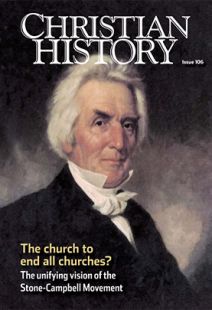Seeking the body of Christ
FROM THE MOMENT the Springfield Presbytery expressed its desire to “sink into union with the body of Christ at large,” the plea of Stone-Campbell Christians has always been that there be only one Church with a capital C—one body of Christ.
Members shy away from descriptions of their tradition as a sect or denomination (“church” with a small “c”). Instead, they identify as a “movement,” a community of concern and understanding within the larger body of Christians throughout the world.
The Stone-Campbell Movement seeks to serve the one church by grounding unity in common faith—“consisting of all those in every place who profess their faith in Christ,” as well as in common scriptural practice—“obedience to him in all things according to the scriptures.”
Recognizing that the limitations of human reasoning prevent any Christian’s perfect understanding of all things in Scripture, the movement still puts its shoulder to the great, continuous, unifying task: restoring the church that was in the mind of Christ and the apostles, found in Scripture.
That the world may believe
While unity and restoration are critical, they cannot be ends in themselves. The movement sees them as means to the end: that the world might know Christ. Thus Stone-Campbell Christians have historically emphasized cross-cultural missions.
Alexander Campbell once suggested that the best missionary approach would involve a church of 20 people going to a country “where they would support themselves like the natives, wear the same garb, adopt the country as their own,” and “sit down and hold forth in word and deed the saving truth, not deriding the gods nor the religion of the natives, but allowing their own works and example to speak for their religion.”
The movement also offers to the church worldwide a high view of baptism and the Lord’s Supper. These precious, authentic symbols—death, burial, resurrection, participation in the body and blood of Christ, immersion, weekly observance of the Supper—are vital to all Christians.
This high view coexists with a belief in the “royal priesthood” of all believers. Any Christian may be called on at any time to preside at the Lord’s table or to baptize the penitent believer. Thus each congregation can prayerfully and freely order its own corporate life.
Finally, aware of both its strengths and weaknesses, the movement frequently engages in lively self-examination of its story and principles by scholars and laity alike. This sometimes involves a recognition of how imperfectly the movement has carried out its own principles. But it also involves a continued commitment to them. CH
By W. Dennis Helsabeck Jr.
[Christian History originally published this article in Christian History Issue #106 in 2013]
W. Dennis Helsabeck Jr. is associate professor emeritus of history at Milligan College in Tennessee and a coauthor of Renewal for Mission—A Concise History of Christian Churches and Churches of Christ.Next articles
Stone-Campbell: Recommended resources
Here are a few books, websites, and past magazine issues recommended by CHI staff and by this issue’s authors to help you through Stone-Campbell history
the editorsOrigin of Conflict
Darwin’s “staggering” theory would have far-reaching implications
John Hedley BrookeSurvival of the [social] fittest
Some of the controversy over Darwin came from how his ideas were applied to economics and race
Matt ForsterWrestling with doubt
How often did the encounter with Darwinism cause a spiritual crisis?
Ronald L. NumbersSupport us
Christian History Institute (CHI) is a non-profit Pennsylvania corporation founded in 1982. Your donations support the continuation of this ministry
Donate



